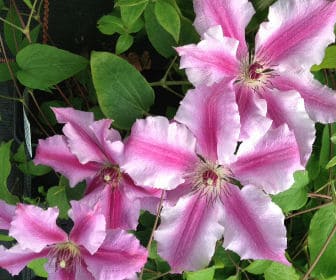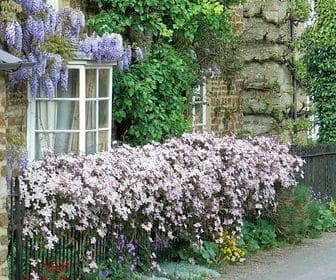Last updated on January 21st, 2022
Our site is reader supported, this means we may earn a small commission from Amazon and other affiliates when you buy through links on our site.
Planting your Clematis
This clematis planting guide is designed for planting a clematis that has been grown in a 2 litre pot or larger.
Where to start
First of all, you will need to dig a hole of approximately 15” (38cm) in diameter and about the same 15 inches in depth. After this, you will need to break up the soil that is at the bottom of the hole and mix compost with a small handful of bonemeal through it. Bonemeal is helpful because it encourages the plant’s root growth.
Planting a clematis


Clematis generally need to be planted deeper than most other garden plants so that the root ball is underneath the soil by about 5” (13cm). Before you plant your new clematis, soak the root ball of the plant in water for about 20 minutes and then you will need to remove all the leaves from the bottom 5 inches of the plant so that only the bare stem is left. Now you need to plant the clematis so that the top of the root ball is 5” (13cm) below ground and back-fill with a mixture of topsoil and good quality compost. Finally, top-dress with a good general fertiliser such as osmocote.
The instructions provided above are ideal for larger clematis in 2/3 litre pots. If you have purchased a smaller plant in a 7cm pot then the same methods apply, however, you may want to just plant the root ball just below the surface about 1-2” so that it isn’t planted too deep. That is unless the clematis is approximately 30cm tall because then you could plant the clematis around 5” below the soil as stated above. Many clematises in 7cm pots have already been pruned back to create bushy plants.
Optional pruning
You can cut a young new plant back by about 50% if you prefer as this will encourage new growth.
Clematis are planted for flowering in the following year, so don’t expect too much growth within the first year, although many do put on plenty of growth and produce plenty of flowers.
Growing clematis in pots
If you are planting your clematis into a pot the same steps as above apply but add 2 inches of gravel to the bottom of the pot to help with drainage and add around four slow-release fertiliser tablets to the compost when planting. Finally, add a 1-inch layer of bark or stone chippings to the surface of the soil as this will help with moisture retention and help prevent weed growth.
Feeding
Clematis benefit well from a good feeding. It encourages a good bloom of flowers and aids it with putting on some excellent growth. From mid-spring, feed them with a good feed about twice a week, following the manufacturer’s instructions until just before flowering. After flowering, feed again until mid-autumn to encourage good growth and flowers again.
A good feed to use is tomato feed, this is available cheaply from most garden centres and supermarkets. It is high in potash so encourages flowering. Specialist clematis feeds can also be purchased should you prefer to use these instead.
Pruning Clematis

The first main rule for pruning is; “if it flowers before June then do not prune”.
Group 1 – No Pruning
These clematises will flower upon the previous season’s growth and they also flower earlier in the season. These include the montana, alpines and macropetalas as well as the evergreen varieties. They only need pruning to remove any dead, weak or diseased growth in late May-June. If you have a clematis in this group that is too big or has grown out of control, then you can prune them back hard down to a couple of feet if needed.
Group 2 – Optional Pruning
Clematis in this group include semi-doubles, doubles, early and large flowering hybrids and they often flower in May-June and September. These can be cut back by about halfway in July and then in February-March dead or weak stems can be removed.
Group 3 – Hard Pruning
Viticellas, herbaceous, species and late large-flowered varieties all fall into this group. They need to be pruned back hard in February-March to two strong leaf buds and this is usually down to around 1ft (30cm) from the ground. If these varieties are not pruned back hard it is likely that the base of the plant will become bare.


